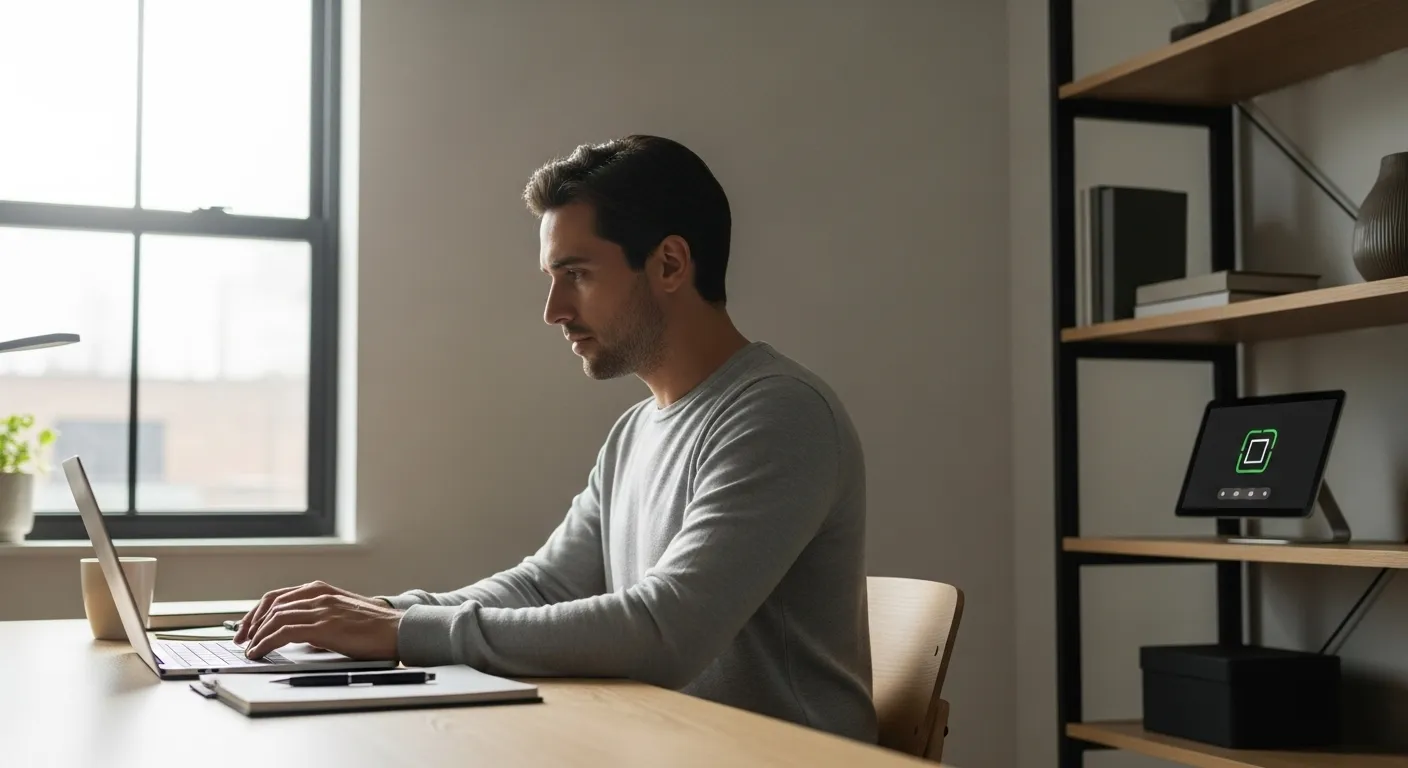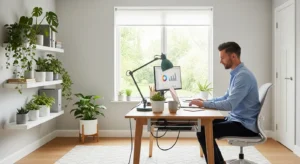
📚 Table of Contents
- The Paradox of the Connected Home
- Understanding the Attention Economy in Your Living Room
- Building Intentional Digital Routines
- Designing Your Environment for Deep Work and Rest
- Putting It Into Practice: Two Simple Scenarios
- Troubleshooting Common Challenges
- Frequently Asked Questions About Smart Homes and Productivity
- Your First Steps to a More Focused Home
The Paradox of the Connected Home
Your smart home was supposed to make life simpler. With a single voice command, you can dim the lights, play your favorite playlist, and check the weather. Technology in the home promised a future of seamless efficiency, freeing up your time and mental energy for the things that truly matter. Yet, for many of us, the reality feels quite different. Instead of feeling liberated, we feel tethered, constantly interrupted by a chorus of chimes, pings, and notifications from the very devices meant to serve us.
The smart display on the kitchen counter flashes a news alert. The smart doorbell announces a package delivery while you’re in the middle of a deep-work session. Your thermostat sends a notification to your phone about energy savings. Each interruption, on its own, seems trivial. But together, they create a persistent state of fractured attention, pulling you out of the moment and making it difficult to concentrate, relax, or connect with the people right in front of you. This is the paradox of modern home technology: it automates tasks but can simultaneously dismantle our focus.
The cost of this constant distraction is higher than we might think. It’s not just about lost minutes in a workday; it’s about the erosion of our ability to think deeply, to be truly present, and to feel genuinely rested. When our attention is perpetually fragmented, our productivity suffers, our stress levels rise, and our overall well-being declines. The constant stream of information can lead to decision fatigue, where even small choices feel overwhelming.
But the solution isn’t to unplug everything and return to a pre-digital existence. That’s neither realistic nor necessary. The goal is to reclaim control, to transform your smart home from a source of distraction into a powerful ally for focus and calm. This article isn’t about digital minimalism in the extreme; it’s about digital intentionality. We will explore practical, sustainable strategies to set healthy boundaries with your devices, allowing you to enjoy the convenience of a connected home without sacrificing your productivity and peace of mind. You can create a home that is both smart and serene.

Understanding the Attention Economy in Your Living Room
To understand why our smart homes can feel so distracting, we need to look at the basic psychology of how our attention works. Our brains are wired to notice novelty and respond to rewards. This mechanism, which was essential for survival in our evolutionary past, is now being constantly activated by our digital devices. Many apps and gadgets are designed to capture and hold our attention, creating a cycle that can be difficult to break.
At the heart of this is a concept known as the dopamine loop. Dopamine is a neurotransmitter in the brain that plays a key role in motivation and reward. When you perform an action that your brain perceives as rewarding—like receiving a social media like, winning a level in a game, or even hearing the satisfying chime of a notification—your brain releases a small amount of dopamine. This feels good, so you’re motivated to repeat the action to get another reward. This creates a feedback loop: cue (a notification), action (checking the phone), and reward (new information). Your smart home is filled with these cues.
Think about your daily interactions with technology. The red badge on an app icon creates an “itch” that you need to scratch by opening it. The “pull-to-refresh” gesture on a social media feed mimics a slot machine, offering the possibility of a reward with every pull. This same principle applies to your home technology. The voice assistant’s friendly response, the notification that your smart laundry is done, or the motion alert from a security camera all act as small, unpredictable rewards that pull your attention away from your primary task.
Every time you switch your focus, even for a moment, you pay a cognitive price. Psychologists refer to this as “attention residue.” When you switch from a focused task (like writing a report) to a quick distraction (like checking a doorbell notification), a part of your brain remains stuck on the previous task. When you return to your work, your focus isn’t as deep as it was before. These micro-interruptions, accumulating throughout the day, prevent you from entering a state of deep work, or “flow,” where you are most creative and productive. As noted by researchers and institutions like the American Psychological Association, task-switching has a measurable impact on cognitive performance.
The challenge with the smart home is that these interruptions are integrated into our physical environment. They are not confined to a screen we can put away. They are in our kitchens, our living rooms, and sometimes even our bedrooms. Recognizing that these devices are designed to trigger these powerful psychological loops is the first step toward reclaiming your focus. It’s not a personal failing; it’s a biological response to a technologically saturated environment. By understanding the mechanism, we can begin to design our routines and spaces to work with our brains, not against them.

Building Intentional Digital Routines
Understanding the “why” behind our distraction is enlightening, but the real power comes from implementing practical changes. The key is to shift from a reactive relationship with your technology to a proactive one. Instead of letting your devices dictate your attention, you can create intentional routines that put you in control. This involves using the features built into your devices to protect your focus, rather than allowing them to fragment it.
Master Your Phone’s Focus Modes
One of the most powerful tools at your disposal is the “Focus Mode” or Do Not Disturb (DND) feature on your smartphone. DND is a setting that silences all incoming calls, texts, and notifications. Modern smartphones allow you to customize these modes for different activities. Instead of a single, all-or-nothing setting, you can create profiles like “Deep Work,” “Family Dinner,” or “Morning Reading.” For your “Deep Work” mode, you might allow calls only from your boss or a specific project team. For “Family Dinner,” you might block everything except calls from the babysitter. This lets you stay connected for true emergencies while eliminating the endless stream of non-urgent pings.
Practice Notification Triage and Batching
Not all notifications are created equal. A security alert from your smart smoke detector is critically important; a notification that your smart coffee maker needs descaling is not. The practice of notification batching involves checking your notifications at scheduled times—say, once at noon and once at 4 PM—rather than responding to them as they arrive. To make this work, you must first perform a notification triage. Go through the settings for each of your smart home apps and be ruthless. Turn off every notification that is not urgent or immediately actionable. Do you really need your phone to buzz when the dishwasher cycle is complete? Probably not. By curating your alerts, you ensure that when a notification does break through, it’s actually worth your attention.
Curate Your Home Screen
Just as a cluttered desk can lead to a cluttered mind, a cluttered phone home screen can trigger distraction. Apply the principles of minimalism to your digital interface. Move all your smart home control apps into a single folder and place it on a secondary screen. Your primary home screen should contain only the essential tools you use for focused work or intentional activities. By adding this small amount of friction—having to swipe and open a folder—you are less likely to mindlessly open an app just to tinker with settings. The goal is to make your phone a tool you use with purpose, not a toy you pick up out of habit.
Use App Timers Strategically
Many of us fall into rabbit holes, opening an app for one quick task and emerging 30 minutes later. Use the screen time or digital wellbeing features on your phone to set daily time limits for specific apps. You might not need a limit on your smart thermostat app, but if you find yourself endlessly browsing for new smart home gadgets on a shopping app that’s linked to your ecosystem, setting a 15-minute daily timer can be a powerful guardrail. This isn’t about restriction for its own sake; it’s about creating awareness and prompting you to ask, “Is this how I want to be spending my time right now?” These routines work together to build a digital infrastructure that supports your goals for productivity and presence.

Designing Your Environment for Deep Work and Rest
Beyond digital routines, your physical environment plays a crucial role in shaping your focus and ability to unwind. A truly smart home is one that is designed to support your mental state, creating clear boundaries between work, relaxation, and family time. By thoughtfully arranging your spaces and leveraging your home technology, you can build an environment that nudges you toward healthier habits.
Establish Screen-Free Zones
One of the most effective strategies for improving both focus and connection is to designate certain areas of your home as screen-free zones. The two most impactful places are typically the dining table and the bedroom. When the dining table is a device-free space, it encourages conversation and mindful eating, strengthening relationships. When the bedroom is free of screens—including phones, tablets, and televisions—it becomes a sanctuary for rest and intimacy. Your brain begins to associate that physical space exclusively with sleep and relaxation, which can significantly improve sleep quality. Keeping charging stations out of the bedroom is a simple but powerful way to enforce this boundary.
Engineer a Sleep-Friendly Evening
Our bodies have a natural sleep-wake cycle that is heavily influenced by light. Exposure to light, particularly blue light from screens and bright overhead LEDs, can suppress the production of melatonin, the hormone that signals your body it’s time to sleep. According to experts at organizations like the Sleep Foundation, managing your light exposure in the evening is critical for healthy sleep. This is where smart lighting can become a powerful tool for wellness. Create an automated “Wind Down” routine that begins 60-90 minutes before your bedtime. The routine can automatically dim your smart bulbs, shift their color temperature to a warm, amber hue, and turn off any non-essential smart displays. This gentle transition signals to your brain that the day is ending, helping you fall asleep more easily and get more restorative rest.
Create Cues for Deep Work
Just as you can create cues for relaxation, you can use your smart home to create cues for focus. If you work from home, it can be difficult to transition into a productive mindset. Use your technology to build a “Deep Work” ritual. This could be a voice command or a tap of a smart button that triggers a specific sequence. For instance, a “Focus Mode” routine could set the lights in your office to a bright, cool white light (which studies suggest can improve alertness), play a specific focus playlist (like classical music or ambient sounds) on a smart speaker, and automatically activate the DND mode on your phone and computer. This ritual acts as a Pavlovian trigger, telling your brain that it’s time to concentrate. By repeating this process consistently, you can train your brain to enter a state of flow more quickly and reliably, making your work-from-home hours significantly more productive.
By thoughtfully designing your environment, you move from being a passive consumer of technology to an active architect of your own attention. You use the same devices that can cause distraction to instead build a supportive framework for the life you want to live—one with ample time for both deep work and deep rest.

Putting It Into Practice: Two Simple Scenarios
Theory is important, but practical application is where real change happens. Let’s walk through two concrete examples of how you can implement these ideas. These aren’t rigid prescriptions but templates you can adapt to your own lifestyle and technology. The goal is to see how small, automated routines can have an outsized impact on your daily well-being.
A 10-Minute Automated Evening Wind-Down
The goal of this routine is to create a frictionless transition from the busyness of the day to a state of calm, preparing your mind and body for sleep. It relies on automation, so it happens every night without you needing to remember or exert willpower.
Let’s say your target bedtime is 10:30 PM. You would set up a smart home routine to trigger automatically at 9:45 PM. Here’s what it could do:
First, your smart lights throughout the main living areas dim to 20% brightness and shift to a warm, candle-like color. The bright overhead light in the kitchen turns off completely. This immediately changes the atmosphere of your home, signaling a shift in energy.
Second, your smart speaker is prompted to stop playing any upbeat music and instead begins playing a pre-selected “Calm” playlist or a quiet, ambient soundscape like gentle rain. The television in the living room automatically turns off.
Third, this routine triggers your smartphone to enter its “Sleep” Focus Mode. This silences all notifications except for calls from your designated emergency contacts. The screen on your phone also dims and may even shift to a grayscale mode to make it less appealing.
This entire sequence takes zero effort from you in the moment. It gently nudges you away from stimulating activities and toward quiet ones, like reading a book, journaling, or having a quiet conversation. It’s a powerful, automated boundary that protects the last, most important hour of your day.
A Realistic Weekend Digital Detox
The idea of a full “digital detox” can feel overwhelming and impractical. A more sustainable approach is a “digital Sabbath” or a period of intentional disconnection. The goal isn’t to abandon technology but to eliminate mindless consumption and create space for other activities. A realistic weekend plan might look like this:
On Saturday morning, from 9 AM to 1 PM, you activate a “Weekend” Focus Mode on your phone. This mode is stricter than your weekday settings, perhaps only allowing phone calls to come through. You communicate this boundary to your family and friends ahead of time: “I’m offline on Saturday mornings but you can call if it’s urgent.”
During this time, you leave your phone in another room and engage in an analog activity: go for a hike, work in the garden, read a physical book, or play a board game with your family. If you want to listen to music or a podcast, you use a smart speaker with a voice command to avoid the temptation of picking up your phone and getting sucked into its vortex of apps.
For the rest of the weekend, you practice the “screen-free zone” rule at the dining table for all meals. This simple act can transform mealtimes from silent, screen-focused affairs into moments of genuine connection. You’re not cutting off technology entirely—you can still use your GPS to navigate to a new restaurant or check movie times—but you are consciously choosing when and how you engage with it, ensuring it serves your life rather than dominating it.

Troubleshooting Common Challenges
Embarking on a journey to create a more focused home is a process, and like any meaningful change, it will come with challenges. It’s important to approach this with self-compassion and a flexible mindset. Perfection is not the goal; progress and intention are. Here’s how to navigate some of the common hurdles you might encounter.
Handling Relapse Moments
There will be days when you fall back into old habits. You’ll find yourself scrolling endlessly before bed or getting distracted by notifications during a work block. When this happens, it’s crucial not to view it as a failure. Instead, treat it as data. Get curious. What triggered the relapse? Were you feeling particularly stressed, bored, or tired? Was a specific notification too tempting to ignore? Use this information to refine your system. Maybe your “Deep Work” mode needs to be stricter, or perhaps your evening wind-down routine needs to start 15 minutes earlier. Every slip-up is an opportunity to learn and adjust.
Navigating FOMO (Fear of Missing Out)
One of the biggest psychological barriers to setting digital boundaries is FOMO. We worry that if we aren’t constantly connected, we’ll miss an important work email, a social invitation, or a breaking news story. Acknowledge that this feeling is real, but also challenge its validity. The vast majority of information that flows through our devices is not urgent. The practice of notification batching is a great antidote to FOMO. By scheduling check-in times, you reassure your anxious brain that you *will* see everything eventually, just on your own terms. Over time, as you experience the deep satisfaction of uninterrupted focus, you’ll start to value JOMO—the Joy of Missing Out—on the constant, low-grade noise.
Managing Social and Family Expectations
Your new habits might affect the people around you. A partner might be used to you responding to texts immediately, or your family might be accustomed to having the TV on during dinner. It’s important to communicate your intentions clearly and kindly. You don’t need to give a lecture on digital wellness. A simple statement works best: “I’m trying to be more present with you, so I’m going to start putting my phone away during our meals.” Or, “I’m working on improving my focus, so I’ll be silencing my notifications between 9 AM and noon.” When you frame your new boundaries as a way to improve your relationships and well-being, most people will be supportive.
Making Exceptions to the Rules
Life is unpredictable. There will be times when you need to break your own rules. A family member might be sick, or a critical project at work might require you to be on-call. Your system should be flexible enough to accommodate this. The goal is not to be a rigid robot but an intentional human. If you need to disable your DND mode for a day, do it without guilt. The difference is that you are making a conscious choice for a specific reason, rather than operating on mindless default. Once the situation has passed, you can return to your established routines. The foundation you’ve built will be there waiting for you.

Frequently Asked Questions About Smart Homes and Productivity
What about privacy concerns with smart home devices? Is that part of digital wellness?
Absolutely. Digital wellness isn’t just about managing your attention; it’s also about feeling safe and in control of your digital life. Privacy is a significant concern with devices that are always listening or watching. To address this, start by choosing products from reputable brands that have a clear commitment to privacy. Always change the default passwords to something strong and unique. Regularly review the privacy settings in your device apps and disable any data sharing or microphone access that isn’t essential for the device’s function. Thinking critically about what data you’re comfortable sharing is a key part of having an intentional relationship with your home technology.
I work night shifts. How can I adapt these tips for a non-traditional schedule?
The principles of creating boundaries and environmental cues remain the same, even if the timing is different. Your “day” is simply inverted. When you get home in the morning, that is your “evening.” You can trigger a “Wind Down” routine that activates blackout smart blinds, plays white noise on a smart speaker, and puts your phone on a strict DND mode to protect your sleep from the daytime world. Your “morning” might be in the late afternoon. You can create a “Wake Up” routine that gradually brightens your smart lights to mimic a sunrise, helping you wake up more naturally. The key is to align your smart home’s behavior with your unique sleep-wake cycle, not the sun’s.
Can these strategies help with managing kids’ screen time too?
Yes, many of these concepts can be adapted for the whole family and can be powerful tools for teaching children healthy tech habits. Using smart home routines to signal transitions can be very effective. For example, you can have a routine that automatically pauses the Wi-Fi on gaming consoles and tablets an hour before bedtime, while simultaneously dimming the lights. This creates a clear, consistent environmental cue that screen time is over. Most importantly, modeling these behaviors yourself—by putting your own phone away during dinner or having screen-free family activities—is the most effective way to instill these values in your children.
My job requires me to be constantly available for emails and messages. How can I possibly set boundaries?
This is a common and difficult challenge. When constant availability is a job requirement, focus on creating “micro-boundaries.” You may not be able to block off a four-hour deep work session, but you might be able to find 25-minute pockets of focused time. Use the Pomodoro Technique (25 minutes of work, 5 minutes of break) and create a Focus Mode that silences everything for just that 25-minute sprint. You can also create boundaries in your physical space. A smart light outside your home office door that turns red when you’re on a call or in a focus sprint can be a simple, non-verbal cue to your family that you shouldn’t be disturbed. The goal is to reclaim small pockets of uninterrupted time, which can add up to significant productivity gains. For broader concerns, research from institutions like the National Institutes of Health can provide context on the health impacts of workplace stress, which may support a conversation with management about team-wide communication expectations.
Are smart speakers always a source of distraction?
Not necessarily. A smart speaker can be either a tool for focus or a portal to distraction, depending entirely on how you use it. When used intentionally, it can be a great productivity asset. You can set timers, ask for quick facts without picking up your phone, or play focus-enhancing soundscapes like white noise or instrumental music. The key is to use it as a utility that keeps you away from your screen. The distraction comes when it’s used for mindless entertainment or frequent, unnecessary queries. Treat it as a tool, not a companion, to keep it on the productivity side of the ledger.

Your First Steps to a More Focused Home
Transforming your relationship with technology doesn’t require a massive overhaul overnight. The most sustainable changes begin with small, deliberate steps that gradually build momentum. The goal is to move from a state of reactive distraction to one of intentional control, making your smart home a genuine asset to your well-being and productivity. Instead of feeling overwhelmed by all the possibilities, choose one or two of the following actions to implement this week.
Here are three small changes you can adopt right away:
First, perform a notification audit on one app. Just one. Pick the smart home app that interrupts you the most. Go into its settings and turn off every single notification that isn’t absolutely critical for safety or security. Experience what it feels like to have one less device vying for your attention.
Second, create one screen-free zone or time. The easiest place to start is the dining table. Commit to putting all phones away for just one meal a day. It could be breakfast, or it could be dinner. The focus is simply on the food and the conversation, without a screen in sight.
Third, set up one simple automated routine. Don’t try to build a complex, multi-step sequence. Start small. Set your smart lights to automatically dim and warm up at 10 PM every night. This single, effortless environmental cue is a powerful first step in creating a more restful evening.
Remember, this is a practice, not a one-time fix. By consistently making small, intentional choices, you can reshape your environment and your habits. You can design a home that is not only connected and efficient but also calm, focused, and truly supportive of the life you want to lead.
Disclaimer
The information provided in this article is for educational and informational purposes only and is not intended as medical or psychological advice. It is not a substitute for professional advice from a qualified healthcare provider. Always seek the advice of your physician or other qualified health professional with any questions you may have regarding a medical condition or mental health concerns.






